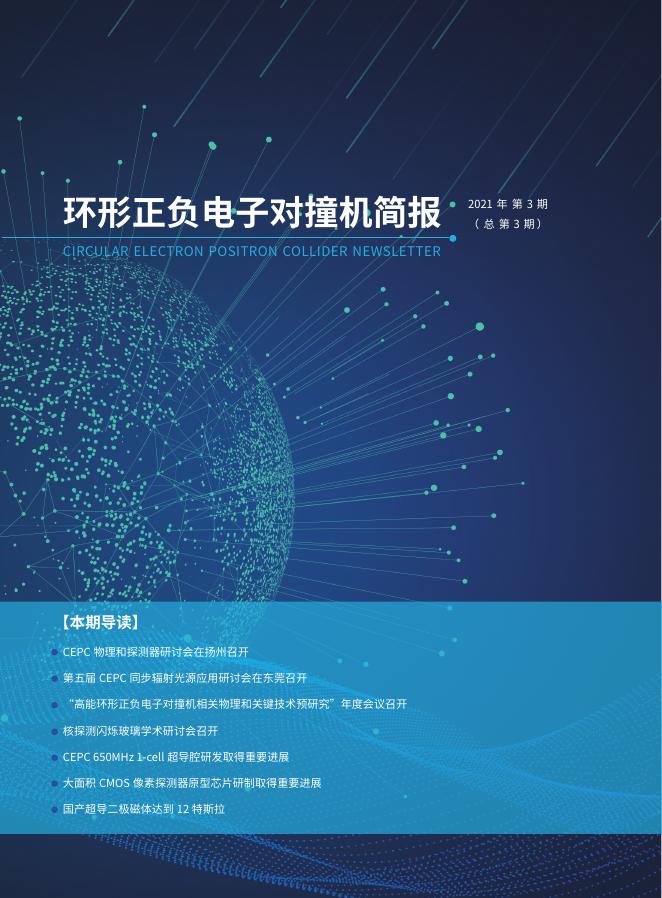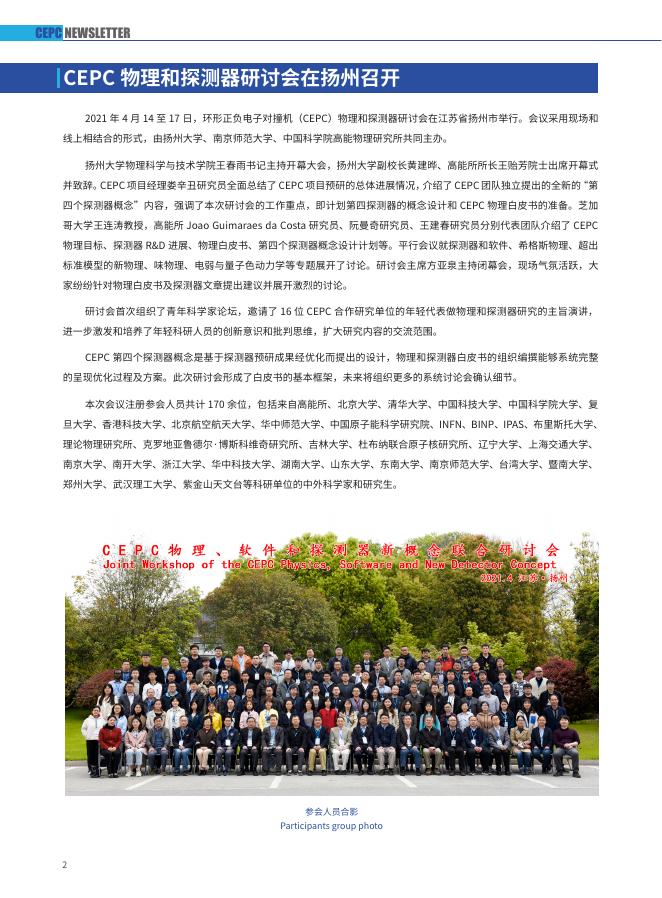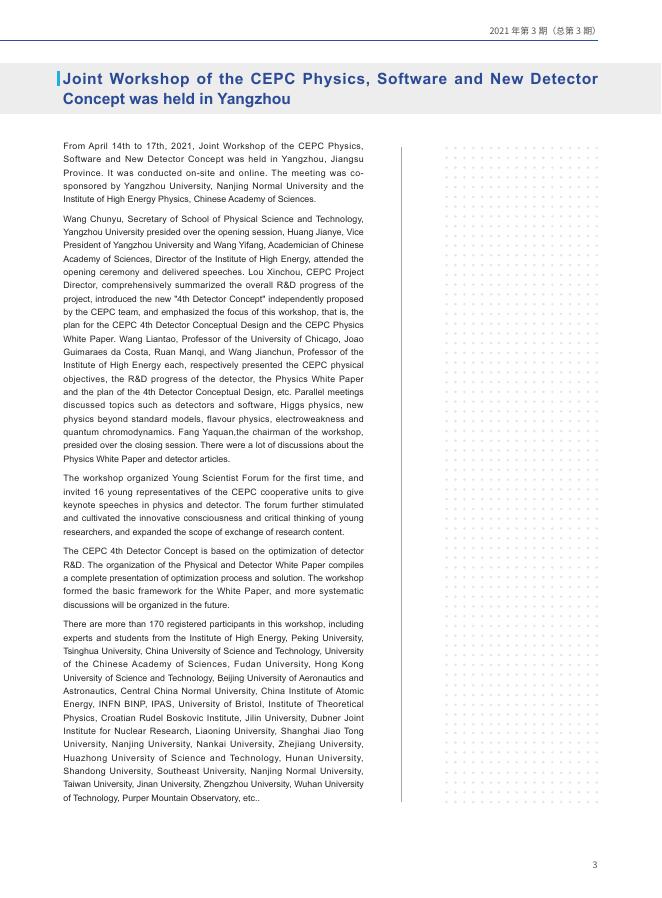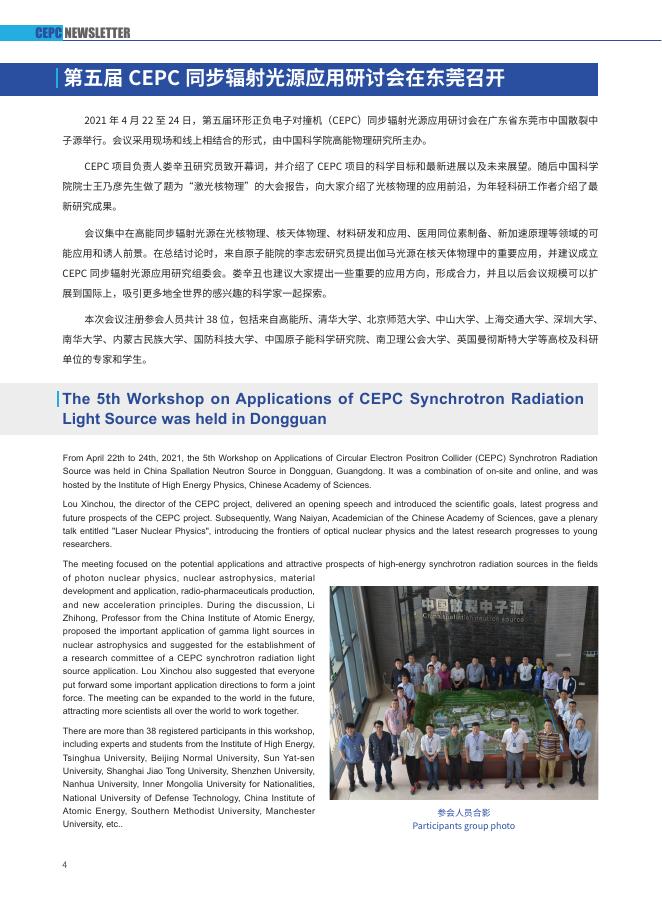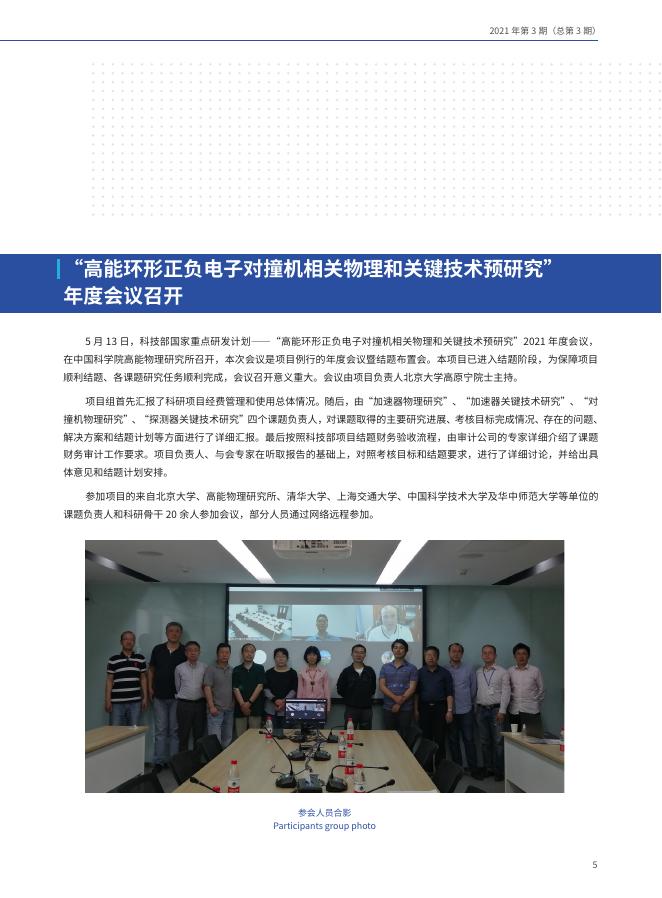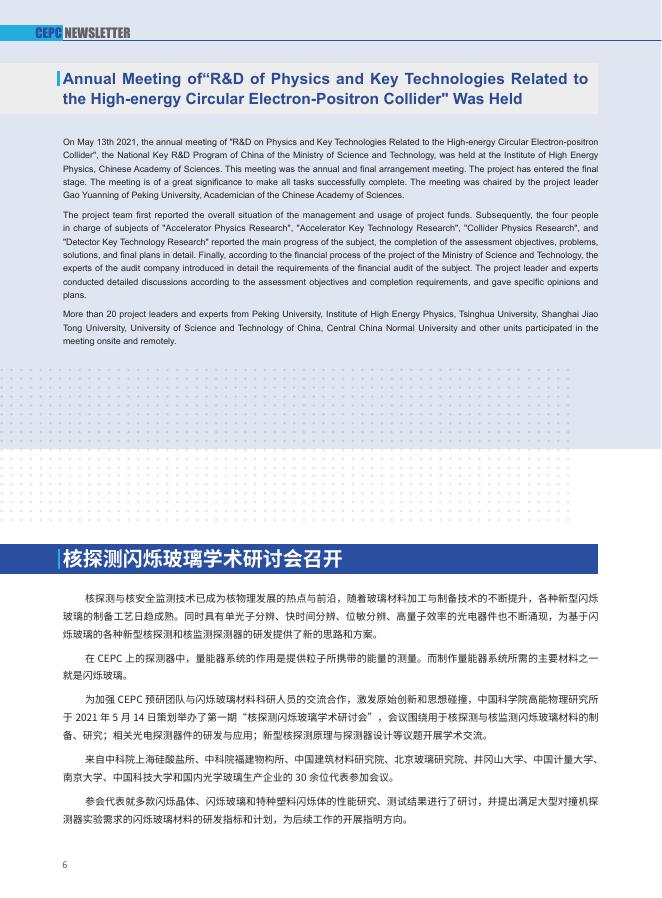CEPC简报 2021年第3期(总第3....pdf
环形正负电子对撞机简报 CIRCULAR ELECTRON POSITRON COLLIDER NEWSLETTER 【本期导读】 CEPC 物理和探测器研讨会在扬州召开 第五届 CEPC 同步辐射光源应用研讨会在东莞召开 “高能环形正负电子对撞机相关物理和关键技术预研究”年度会议召开 核探测闪烁玻璃学术研讨会召开 CEPC 650MHz 1-cell 超导腔研发取得重要进展 大面积 CMOS 像素探测器原型芯片研制取得重要进展 国产超导二极磁体达到 12 特斯拉 2021 年 第 3 期 ( 总 第 3 期) CEPC NEWSLETTER CEPC 物理和探测器研讨会在扬州召开 2021 年 4 月 14 至 17 日,环形正负电子对撞机(CEPC)物理和探测器研讨会在江苏省扬州市举行。会议采用现场和 线上相结合的形式,由扬州大学、南京师范大学、中国科学院高能物理研究所共同主办。 扬州大学物理科学与技术学院王春雨书记主持开幕大会,扬州大学副校长黄建晔、高能所所长王贻芳院士出席开幕式 并致辞。CEPC 项目经理娄辛丑研究员全面总结了 CEPC 项目预研的总体进展情况,介绍了 CEPC 团队独立提出的全新的“第 四个探测器概念”内容,强调了本次研讨会的工作重点,即计划第四探测器的概念设计和 CEPC 物理白皮书的准备。芝加 哥大学王连涛教授,高能所 Joao Guimaraes da Costa 研究员、阮曼奇研究员、王建春研究员分别代表团队介绍了 CEPC 物理目标、探测器 R&D 进展、物理白皮书、第四个探测器概念设计计划等。平行会议就探测器和软件、希格斯物理、超出 标准模型的新物理、味物理、电弱与量子色动力学等专题展开了讨论。研讨会主席方亚泉主持闭幕会,现场气氛活跃,大 家纷纷针对物理白皮书及探测器文章提出建议并展开激烈的讨论。 研讨会首次组织了青年科学家论坛,邀请了 16 位 CEPC 合作研究单位的年轻代表做物理和探测器研究的主旨演讲, 进一步激发和培养了年轻科研人员的创新意识和批判思维,扩大研究内容的交流范围。 CEPC 第四个探测器概念是基于探测器预研成果经优化而提出的设计,物理和探测器白皮书的组织编撰能够系统完整 的呈现优化过程及方案。此次研讨会形成了白皮书的基本框架,未来将组织更多的系统讨论会确认细节。 本次会议注册参会人员共计 170 余位,包括来自高能所、北京大学、清华大学、中国科技大学、中国科学院大学、复 旦大学、香港科技大学、北京航空航天大学、华中师范大学、中国原子能科学研究院、INFN、BINP、IPAS、布里斯托大学、 理论物理研究所、克罗地亚鲁德尔·博斯科维奇研究所、吉林大学、杜布纳联合原子核研究所、辽宁大学、上海交通大学、 南京大学、南开大学、浙江大学、华中科技大学、湖南大学、山东大学、东南大学、南京师范大学、台湾大学、暨南大学、 郑州大学、武汉理工大学、紫金山天文台等科研单位的中外科学家和研究生。 参会人员合影 Participants group photo 2 2021 年第 3 期(总第 3 期) Joint Workshop of the CEPC Physics, Software and New Detector Concept was held in Yangzhou From April 14th to 17th, 2021, Joint Workshop of the CEPC Physics, Software and New Detector Concept was held in Yangzhou, Jiangsu Province. It was conducted on-site and online. The meeting was cosponsored by Yangzhou University, Nanjing Normal University and the Institute of High Energy Physics, Chinese Academy of Sciences. Wang Chunyu, Secretary of School of Physical Science and Technology, Yangzhou University presided over the opening session, Huang Jianye, Vice President of Yangzhou University and Wang Yifang, Academician of Chinese Academy of Sciences, Director of the Institute of High Energy, attended the opening ceremony and delivered speeches. Lou Xinchou, CEPC Project Director, comprehensively summarized the overall R&D progress of the project, introduced the new "4th Detector Concept" independently proposed by the CEPC team, and emphasized the focus of this workshop, that is, the plan for the CEPC 4th Detector Conceptual Design and the CEPC Physics White Paper. Wang Liantao, Professor of the University of Chicago, Joao Guimaraes da Costa, Ruan Manqi, and Wang Jianchun, Professor of the Institute of High Energy each, respectively presented the CEPC physical objectives, the R&D progress of the detector, the Physics White Paper and the plan of the 4th Detector Conceptual Design, etc. Parallel meetings discussed topics such as detectors and software, Higgs physics, new physics beyond standard models, flavour physics, electroweakness and quantum chromodynamics. Fang Yaquan,the chairman of the workshop, presided over the closing session. There were a lot of discussions about the Physics White Paper and detector articles. The workshop organized Young Scientist Forum for the first time, and invited 16 young representatives of the CEPC cooperative units to give keynote speeches in physics and detector. The forum further stimulated and cultivated the innovative consciousness and critical thinking of young researchers, and expanded the scope of exchange of research content. The CEPC 4th Detector Concept is based on the optimization of detector R&D. The organization of the Physical and Detector White Paper compiles a complete presentation of optimization process and solution. The workshop formed the basic framework for the White Paper, and more systematic discussions will be organized in the future. There are more than 170 registered participants in this workshop, including experts and students from the Institute of High Energy, Peking University, Tsinghua University, China University of Science and Technology, University of the Chinese Academy of Sciences, Fudan University, Hong Kong University of Science and Technology, Beijing University of Aeronautics and Astronautics, Central China Normal University, China Institute of Atomic Energy, INFN BINP, IPAS, University of Bristol, Institute of Theoretical Physics, Croatian Rudel Boskovic Institute, Jilin University, Dubner Joint Institute for Nuclear Research, Liaoning University, Shanghai Jiao Tong University, Nanjing University, Nankai University, Zhejiang University, Huazhong University of Science and Technology, Hunan University, Shandong University, Southeast University, Nanjing Normal University, Taiwan University, Jinan University, Zhengzhou University, Wuhan University of Technology, Purper Mountain Observatory, etc.. 3 CEPC NEWSLETTER 第五届 CEPC 同步辐射光源应用研讨会在东莞召开 2021 年 4 月 22 至 24 日,第五届环形正负电子对撞机(CEPC)同步辐射光源应用研讨会在广东省东莞市中国散裂中 子源举行。会议采用现场和线上相结合的形式,由中国科学院高能物理研究所主办。 CEPC 项目负责人娄辛丑研究员致开幕词,并介绍了 CEPC 项目的科学目标和最新进展以及未来展望。随后中国科学 院院士王乃彦先生做了题为“激光核物理”的大会报告,向大家介绍了光核物理的应用前沿,为年轻科研工作者介绍了最 新研究成果。 会议集中在高能同步辐射光源在光核物理、核天体物理、材料研发和应用、医用同位素制备、新加速原理等领域的可 能应用和诱人前景。在总结讨论时,来自原子能院的李志宏研究员提出伽马光源在核天体物理中的重要应用,并建议成立 CEPC 同步辐射光源应用研究组委会。娄辛丑也建议大家提出一些重要的应用方向,形成合力,并且以后会议规模可以扩 展到国际上,吸引更多地全世界的感兴趣的科学家一起探索。 本次会议注册参会人员共计 38 位,包括来自高能所、清华大学、北京师范大学、中山大学、上海交通大学、深圳大学、 南华大学、内蒙古民族大学、国防科技大学、中国原子能科学研究院、南卫理公会大学、英国曼彻斯特大学等高校及科研 单位的专家和学生。 The 5th Workshop on Applications of CEPC Synchrotron Radiation Light Source was held in Dongguan From April 22th to 24th, 2021, the 5th Workshop on Applications of Circular Electron Positron Collider (CEPC) Synchrotron Radiation Source was held in China Spallation Neutron Source in Dongguan, Guangdong. It was a combination of on-site and online, and was hosted by the Institute of High Energy Physics, Chinese Academy of Sciences. Lou Xinchou, the director of the CEPC project, delivered an opening speech and introduced the scientific goals, latest progress and future prospects of the CEPC project. Subsequently, Wang Naiyan, Academician of the Chinese Academy of Sciences, gave a plenary talk entitled "Laser Nuclear Physics", introducing the frontiers of optical nuclear physics and the latest research progresses to young researchers. The meeting focused on the potential applications and attractive prospects of high-energy synchrotron radiation sources in the fields of photon nuclear physics, nuclear astrophysics, material development and application, radio-pharmaceuticals production, and new acceleration principles. During the discussion, Li Zhihong, Professor from the China Institute of Atomic Energy, proposed the important application of gamma light sources in nuclear astrophysics and suggested for the establishment of a research committee of a CEPC synchrotron radiation light source application. Lou Xinchou also suggested that everyone put forward some important application directions to form a joint force. The meeting can be expanded to the world in the future, attracting more scientists all over the world to work together. There are more than 38 registered participants in this workshop, including experts and students from the Institute of High Energy, Tsinghua University, Beijing Normal University, Sun Yat-sen University, Shanghai Jiao Tong University, Shenzhen University, Nanhua University, Inner Mongolia University for Nationalities, National University of Defense Technology, China Institute of Atomic Energy, Southern Methodist University, Manchester University, etc.. 4 参会人员合影 Participants group photo 2021 年第 3 期(总第 3 期) “高能环形正负电子对撞机相关物理和关键技术预研究” 年度会议召开 5 月 13 日,科技部国家重点研发计划——“高能环形正负电子对撞机相关物理和关键技术预研究”2021 年度会议, 在中国科学院高能物理研究所召开,本次会议是项目例行的年度会议暨结题布置会。本项目已进入结题阶段,为保障项目 顺利结题、各课题研究任务顺利完成,会议召开意义重大。会议由项目负责人北京大学高原宁院士主持。 项目组首先汇报了科研项目经费管理和使用总体情况。随后,由“加速器物理研究”、“加速器关键技术研究”、“对 撞机物理研究”、“探测器关键技术研究”四个课题负责人,对课题取得的主要研究进展、考核目标完成情况、存在的问题、 解决方案和结题计划等方面进行了详细汇报。最后按照科技部项目结题财务验收流程,由审计公司的专家详细介绍了课题 财务审计工作要求。项目负责人、与会专家在听取报告的基础上,对照考核目标和结题要求,进行了详细讨论,并给出具 体意见和结题计划安排。 参加项目的来自北京大学、高能物理研究所、清华大学、上海交通大学、中国科学技术大学及华中师范大学等单位的 课题负责人和科研骨干 20 余人参加会议,部分人员通过网络远程参加。 参会人员合影 Participants group photo 5 CEPC NEWSLETTER Annual Meeting of“R&D of Physics and Key Technologies Related to the High-energy Circular Electron-Positron Collider" Was Held On May 13th 2021, the annual meeting of "R&D on Physics and Key Technologies Related to the High-energy Circular Electron-positron Collider", the National Key R&D Program of China of the Ministry of Science and Technology, was held at the Institute of High Energy Physics, Chinese Academy of Sciences. This meeting was the annual and final arrangement meeting. The project has entered the final stage. The meeting is of a great significance to make all tasks successfully complete. The meeting was chaired by the project leader Gao Yuanning of Peking University, Academician of the Chinese Academy of Sciences. The project team first reported the overall situation of the management and usage of project funds. Subsequently, the four people in charge of subjects of "Accelerator Physics Research", "Accelerator Key Technology Research", "Collider Physics Research", and "Detector Key Technology Research" reported the main progress of the subject, the completion of the assessment objectives, problems, solutions, and final plans in detail. Finally, according to the financial process of the project of the Ministry of Science and Technology, the experts of the audit company introduced in detail the requirements of the financial audit of the subject. The project leader and experts conducted detailed discussions according to the assessment objectives and completion requirements, and gave specific opinions and plans. More than 20 project leaders and experts from Peking University, Institute of High Energy Physics, Tsinghua University, Shanghai Jiao Tong University, University of Science and Technology of China, Central China Normal University and other units participated in the meeting onsite and remotely. 核探测闪烁玻璃学术研讨会召开 核探测与核安全监测技术已成为核物理发展的热点与前沿,随着玻璃材料加工与制备技术的不断提升,各种新型闪烁 玻璃的制备工艺日趋成熟。同时具有单光子分辨、快时间分辨、位敏分辨、高量子效率的光电器件也不断涌现,为基于闪 烁玻璃的各种新型核探测和核监测探测器的研发提供了新的思路和方案。 在 CEPC 上的探测器中,量能器系统的作用是提供粒子所携带的能量的测量。而制作量能器系统所需的主要材料之一 就是闪烁玻璃。 为加强 CEPC 预研团队与闪烁玻璃材料科研人员的交流合作,激发原始创新和思想碰撞,中国科学院高能物理研究所 于 2021 年 5 月 14 日策划举办了第一期“核探测闪烁玻璃学术研讨会”,会议围绕用于核探测与核监测闪烁玻璃材料的制 备、研究;相关光电探测器件的研发与应用;新型核探测原理与探测器设计等议题开展学术交流。 来自中科院上海硅酸盐所、中科院福建物构所、中国建筑材料研究院、北京玻璃研究院、井冈山大学、中国计量大学、 南京大学、中国科技大学和国内光学玻璃生产企业的 30 余位代表参加会议。 参会代表就多款闪烁晶体、闪烁玻璃和特种塑料闪烁体的性能研究、测试结果进行了研讨,并提出满足大型对撞机探 测器实验需求的闪烁玻璃材料的研发指标和计划,为后续工作的开展指明方向。 6 2021 年第 3 期(总第 3 期) FAST Scintillation Material Workshop Was Held Nuclear detection and nuclear safety monitoring technologies have become the hotspots and frontiers in the development of nuclear physics. With the continuous improvement of glass material processing and preparation technologies, the preparation techniques of various new scintillation glasses have become increasingly mature. At the same time, optoelectronic devices with single photon resolution, fast time resolution, position-sensitive resolution, and high quantum efficiency are also emerging, providing new ideas and solutions for the research and development of various new types of nuclear detection and nuclear monitoring detectors based on scintillation glass. In the detectors of the CEPC, the calorimeter function is to provide the measurement of the energy carried by particles. One of the main materials required to make calorimeter is scintillation glass. In order to strengthen the exchanges and cooperation between the CEPC R&D team and the scintillating glass material researchers, and stimulate original innovation and collision of ideas, the Institute of High Energy Physics, Chinese Academy of Sciences planned and held the first "FAST Scintillation Material Workshop " on May 14th, 2021.The meeting was focus on the preparation and research of scintillation glass materials for nuclear detection and nuclear monitoring; the development and application of related photodetectors; new nuclear detection principles and detector design and other topics related. More than 30 representatives from Shanghai Institute of Ceramics, Chinese Academy of Sciences, Fujian Institute of Physics, Chinese Academy of Sciences, China Building Materials Academy, Beijing Glass Research Institute Co., Ltd., Jinggangshan University, China Jiliang University, Nanjing University, University of Science and Technology of China and other domestic optical glass manufacturers participated in the meeting. Participants discussed the performance research and test results of a variety of scintillation crystals, scintillation glasses and special plastic scintillators, and put forward R&D indicators and plans for scintillation glass materials that meet the experimental needs of largescale collider detectors. The work plan is clear for the future. 参会人员合影 Participants group photo 7 CEPC NEWSLETTER CEPC 650MHz 1-cell 超导腔研发取得重要进展 2021 年 4 月 30 日,中科院高能所加速器中心研制的两只环形正负电子对撞机 (CEPC) 650 MHz 1-cell 超导腔(650S4、 650S7)完成了垂直测试。测试结果显示:在 2K 温度下,650S4 的品质因数 Q 值达到 2.7E10@35MV/m,650S7 的 Q 值 达到 3.6E10@32MV/m。该结果创造了国内低频率(<1GHz)椭球型超导腔加速梯度的最高记录,与世界领先水平相当。 这两只 650 MHz 1-cell 超导腔的研发充分借鉴了之前高能所 1.3 GHz 超导腔研发的成功经验:650S4 是一只细晶粒超 导腔,采用了重化学抛光 + 轻电抛光的技术路线;650S7 则是一只大晶粒超导腔,先采用柔性(流体)抛光处理了表面的缺陷, 再进行轻电抛光处理。 下一步,课题组将优化工艺,进一步提高 650 MHz 1-cell 超导腔(尤其是大晶粒)的加速梯度和品质因数,并从 1-cell 向 2-cell 推广。 本项研究工作得到了先进光源研发与测试平台 (PAPS)、CEPC 预研项目的大力支持。 Significant progress has been made in the development of CEPC 650MHz 1-cell superconducting cavity The Circular Electron Positron Collider (CEPC) at IHEP made an important breakthrough on April 30th ,2021. Two of its 650 MHz 1-cell cavities (650S4 and 650S7) reached 2.7E10@35MV/m and 3.6E10@32MV/m, respectively, in a vertical test at 2.0 K. The results have broken China's gradient record for low-frequency (<1 GHz) elliptical cavities and now rank in the top level worldwide. Based on the successful experience of 1.3 GHz cavities at IHEP, these two 650 MHz 1-cell cavities have achieved both high quality factor (Q) and high accelerating gradient (Eacc). 650S4, which is made of fine-grain niobium, received bulk buffered chemical polishing (BCP) and light electro-polishing (EP). 650S7, which is made of large-grain niobium, received flexible polishing to repair surface defects, followed by light EP. In the future, relevant techniques will be optimized to further improve the Q and Eacc of 650 MHz 1-cell cavities and applied to 650 MHz 2-cell cavities. This work was supported by the Platform for Advanced Photon Source Technology R&D and pre-research project of CEPC. CEPC 650 MHz 1-cell 超导腔测试结果(fine grain,细晶粒。large grain,大晶粒) Vertical test results for CEPC 650 MHz 1-cell cavities 8 2021 年第 3 期(总第 3 期) 大面积 CMOS 像素探测器原型芯片研制取得重要进展 为精确测量希格斯玻色子性质,需要实现高精度的粒子径迹重建、高精度轻子动量测量和衰变顶点重建等需求,因此, 研制高精度、低物质量且抗辐照的径迹探测器至关重要。CMOS 像素探测器(CMOS Pixel Sensor)技术将传感器(sensor) 和信号处理电路集成在同一 ASIC 芯片(ASIC chip)上,芯片可以减薄至约 50 微米,从而降低探测器的物质量以提高粒 子动量的测量精度。并且,CMOS 像素探测器在空间分辨率、低功耗和读出速度各方面具有很大的优势,是 CEPC 候选探 测器技术之一。 为实现 CEPC 的探测需求,高能所等单位的研发团队于 2018 年开始便致力于研发一款名为 TaichuPix 的 CMOS 像素 探测器原型芯片,其目标是实现空间分辨率达到世界先进水平 3-5 微米的高精度、抗辐照能力高于 1 Mrad 总电离剂量、 探测面积大并具有完整的数据处理功能,可安装在径迹探测器原型机上。 TaichuPix 芯片基于 180 nm CMOS 图像传感器工艺设计,目前设计团队已经完成了两个小规模原型芯片 (25 mm2) 的设计、生产和性能验证。TaichuPix-2 芯片包含了 64 行 ×192 列的像素单元阵列和完整的外围电路功能模块,像素尺寸 为 25 μm × 25 μm,预期可以实现小于 5 微米的空间分辨率。通过输入电信号、放射源信号(90Sr、X-ray)以及红外激 光,验证了 TaichuPix-2 芯片主要功能模块工作正常,像素的噪声和阈值水平基本与设计相符,满足项目需求。设计团队 对 TaichuPix-2 芯片进行了电离辐照测试,结果表明芯片在接受 30 Mrad 累计剂量辐照后,功能完全正常,噪声性能无明 显恶化(参见图一)。设计团队已完成第一版全尺寸 TaichuPix 原型芯片的设计,芯片尺寸约 2.6 cm × 1.6 cm(参见图二), 即将提交生产。全尺寸 TaichuPix 芯片采用数据驱动式读出,读出每个被击中像素需要 50 ns,可以满足 36 MHz/cm2 的 事例率,所有电路模块的设计均已在 TaichuPix-2 芯片中被测试验证。芯片可以兼容自触发和外触发两种工作模式,功耗 密度约 100-200 mW/cm2。 本项目是科技部国家重点研发计划“高能环形正负电子对撞机关键技术研发和验证”项目“硅像素探测器关键技术验证” 子课题的任务之一,由高能所承担,山东大学、南京大学、西北工业大学、西班牙 IFEA 研究所共同参与。 Significant Progress Has Been Made in the Development of Large-area CMOS Pixel Sensor Prototype Chip In order to accurately measure the properties of the Higgs boson, it is necessary to achieve high-precision particle track reconstruction, high-precision lepton momentum measurement, and decay vertex reconstruction. Therefore, to develop a detector with a high-precision, low-mass, and radiation-resistant track is crucial. CMOS Pixel Sensor technology integrates the sensor and signal processing circuit on the same ASIC chip. The chip can be thinned to about 50 microns to reduce the mass of the detector and increase measurement accuracy of the particle momentum. In addition, CMOS pixel sensor has great advantages in spatial resolution, low power consumption and readout speed, and is one of the candidate detector technologies for the CEPC. In order to meet the detection demands of the CEPC, the R&D team of IHEP and other units have been committed to the development of a prototype CMOS pixel sensor called TaichuPix since 2018. The goal is to achieve a spatial resolution of 3-5 microns of the highprecision in the world's leading level,an anti-irradiation ability of higher than 1 Mrad of total ionization dose, a large detection area and a complete data processing function, which can be installed on the prototype track detector. The TaichuPix chip is based on the 180 nm CMOS image sensor process design. At present, the R&D team has completed the design, production and performance verification of two small-scale prototype chips (25 mm2). The TaichuPix-2 chip includes a 64-row × 192-column pixel unit array and complete peripheral circuit function modules. The pixel size is 25 μm × 25 μm, which is expected to achieve a spatial resolution of less than 5 μm. By the input of electrical signals, radioactive source signals (90Sr, X-ray) and infrared lasers, it is verified that the main functional modules of the TaichuPix-2 chip are working properly, and the noise and threshold levels of the pixels are basically in line with the design, meeting the demands of the project. The team conducted an ionizing radiation test on the TaichuPix-2 chips, and the results showed that the chips were in good performances after a cumulative dose of 30 Mrad, and the 9 CEPC NEWSLETTER noise performances were not significantly deteriorated (see Figure 1). The team has completed the design of the first version of the fullsize TaichuPix prototype chips of about 2.6 cm × 1.6 cm (see Figure 2). The chips will be submitted for production soon. The full-size TaichuPix chip adopts data-driven readout. It takes 50 ns to read out each pixel hit, which can meet the case rate of 36 MHz/cm2. The design of all circuit modules have been tested and verified in the TaichuPix-2 chip. The chip is compatible with two working modes of self-triggering and external one, and the power consumption density is about 100-200 mW/cm2. This project is one of the tasks of the “Key Technologies Verification of Silicon Pixel Sensor”,which is the subject of the project of “R&D and Verification of Key Technologies for the CEPC”,the National Key R&D Program of the Ministry of Science and Technology. The project is undertaken by IHEP,CAS and in cooperation with Shandong University, Nanjing University, Northwestern Polytechnical University, and Spanish IFEA Institute. 图一:TaichuPix-2 芯片在电离辐照前后的像素噪声和阈值性能 Figure 1: Pixel noise and threshold performance of TaichuPix-2 chip before and after irradiation 图二:全尺寸 TaichuPix 原型芯片版图 Figure 2: Full-size TaichuPix prototype chip layout 10 2021 年第 3 期(总第 3 期) 国产超导二极磁体达到 12 特斯拉 中国科学院高能物理研究所(IHEP)高场超导磁体团队在 6 月 13 日结束的新一轮性能测试中取得进展。该团队研制 的二极磁体磁场超过 12 T(特斯拉)在 4.2 K 的两个孔径中,达到超导线材临界性能容量的 85% 以上。这种磁体,包括其 设计、超导材料、电缆、线圈以及相关设备和平台,都是基于国内技术。 目前,无孔径二极磁体的磁场记录为 16 T,由欧 洲核研究组织 (CERN) 持有。单孔径二极磁体的记录是 14 T,费米实验室刚刚在 2020 年实现。双孔径 12 T 的成就处于该 领域的最前沿。此外,该磁体是目前世界上唯一一种使用不同超导材料组合来实现 12 T 二极场强度的磁体。这是中国高场 加速器磁体发展的里程碑。 前欧洲核子研究中心大型强子对撞机高光度升级(HL-LHC)项目负责人、现任米兰大学教授 卢西奥·罗西等国际同行向 IHEP 团队发来贺信。 高场超导磁体提供的强磁场可以控制高能带电粒子束的轨迹和大小,这是 基础物理研究、先进核聚变能技术、高能粒子加速器建设、高场超导磁体技术已被欧美国家列为未来十年高能物理发展的 重点核心技术之一。国际国内开展的聚变反应堆研发项目也强烈依赖高场磁体技术。 性能大幅提升的下一代高场超导磁体 也有望广泛应用于高精度医疗系统、低损耗电气系统、交通系统等。 Domestic Superconducting Dipole Magnet Reaches 12 Tesla The high-field superconducting magnet team of Institute of High in Europe and the United States. Fusion reactor R&D programs Energy Physics (IHEP) of the Chinese Academy of Sciences has made progress in a new round of performance test that ended on June 13. The magnetic field of the dipole magnet developed carried out internationally and domestically also strongly rely on high-field magnet technology. by the team exceeded 12 T (Tesla) in two apertures at 4.2 K, reaching more than 85% of the critical performance capacity of the superconducting wire. This magnet, including its design, superconducting materials, cables, coils, and related equipment and platform, is based on domestic technologies. The next-generation high-field superconducting magnets with greatly improved performance are also expected to be widely used in high-precision medical systems, low-loss electrical systems, transportation systems, etc. At present, the magnetic field record for a dipole magnet without aperture is 16 T and is held by the European Organization for Nuclear Research (CERN). The record for a single-aperture dipole magnet is 14 T and was just achieved by Fermilab in 2020. An achievement of 12 T with twin aperture is at the forefront of the field. Furthermore, this magnet is currently the only one in the world that uses a combination of different superconducting materials to achieve a 12 T dipole field strength. It is a milestone in the development of high field accelerator magnets in China. Experts including Lucio Rossi, former project leader of the CERN Large Hadron Collider High Luminosity Upgrade (HL-LHC) and currently the professor at the University of Milan, and other international colleagues, sent congratulatory letters to the IHEP team. The strong magnetic field provided by the high-field superconducting magnet can control the trajectory and size of the high-energy charged particle beam, which is the core requirement of basic physics research, advanced nuclear fusion energy technology, high-energy particle accelerator construction, etc. High-field superconducting magnet technology has been listed as one of the top priority core technologies for the development of high-energy physics over the next ten years Training history of the domestic route 12-T dipole magnet 11 CONTENTS ■ Joint Workshop of the CEPC Physics, Software and New Detector Concept was held in Yangzhou ■ The 5th Workshop on Applications of CEPC Synchrotron Radiation Light Source was held in Dongguan ■ Annual Meeting of“R&D of Physics and Key Technologies Related to the High-energy Circular ElectronPositron Collider" Was Held ■ FAST Scintillation Material Workshop Was Held ■ Significant progress has been made in the development of CEPC 650MHz 1-cell superconducting cavity ■ Significant Progress Has Been Made in the Development of Large-area CMOS Pixel Sensor Prototype Chip ■ Domestic Superconducting Dipole Magnet Reaches 12 Tesla 环形正负电子对撞机简报(季刊) 主办:环形正负电子对撞机研究组 地址:北京市石景山区玉泉路 19 号(乙) 邮编: 100049 Email:cepc-news-editors@maillist.ihep.ac.cn 欢迎关注 CEPC 网站

 CEPC简报 2021年第3期(总第3....pdf
CEPC简报 2021年第3期(总第3....pdf 